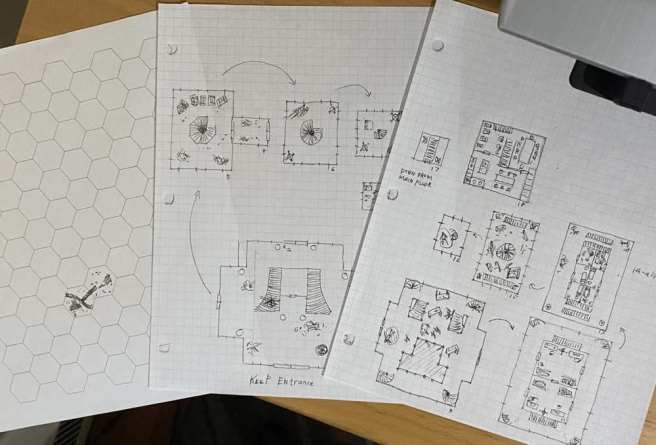I’m now just over a couple of weeks into the Dungeon23 challenge, and it’s actually going pretty well. I’m still feeling my way into the challenge, but we’ve only just begun. As it progresses, I should get a better handle on my voice in the process.
As mentioned in my first Dungeon23 post, I’m wanted to do some overland hex mapping, as in addition to dungeon design. Well, I started with some hex mapping (see images below), but then instead of delving into a dungeon, I found a keep and began mapping something above ground. The mapping and points of interest came from the Pocket Lands (and D100 Lands) tables. I figured I’d follow what the dice rolls decided.
My initial descriptions started out as if I was playing the game (as omnipotent observers) surveying the land and objects. After four or five days I switched to a more descriptive language, and dropped the “we are” and “we see” language. I’m still ironing out how I’m filling out the descriptions of the rooms and areas, but I’m sure I’ll nail it down soon. I’m definitely new to this sort of thing, so a bit of “figuring it out” should be expected.
Here is an in-progress photo of my initial hex crawl map, as well as the design of the keep itself (which still hasn’t been fully exposed):
I remember how I would design castles and dungeons on graph paper way, way back in the day and this is bringing those memories back in waves. Whether what I’m working on now will every be used, I can’t say, but it’s been so much fun so far.
I should also add that I have a new resource for building out this world, and that’s Matthew Finch’s Tome of Adventure Design. I replied to a post on dice.camp by Sean Kelley (go and subscribe to Sean’s excellent YouTube channel: How 2 RPG), where he was showing his new hardcover edition of the book. He offered to sell me his first edition softcover, and of course I jumped at the opportunity. I’ve only just begun to dig into the massive trove of content tables, but I’m positive it will become a very handy resource.
I’m still a bit hesitant to share much of what I’ve written as the descriptions of what I’ve been uncovering in Dungeon23. But, I think once I get a better hang of what I’m doing, and my writing style gets a bit more solid, I may share some excerpts here and there.
Now, let’s see what’s happening in the basement of that keep…

